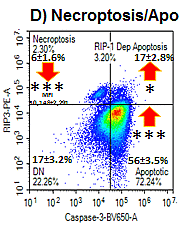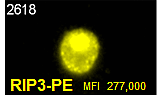Imaging necroptosis with RIP3
RIP3 is up-regulated in expression in live cells when undergoing necroptosis indcued by either TNFa or shikonin. After gating upon RIP3+ve only live cells RIP3 MFI calculated by flow cytoemtry and upon Imagestream analysis which confirmed the presence of live necroptotic cells. Blockade of TNFa and shikonin induced necroptosis was confrmed by the use of GSK'481, necrostatin-1 and zVAD, see figure.
Imaging RIP1-dependent apoptosis
Live and dead RIP1-dependent apoptosis can be phenotyped by the use of a fixable cell viability dye (Zombie NIR), RIP3 and active caspase-3 antibodies. These were analyse flow cytometrically and imaged by Imagestream image analysis, see figure.
Imaging Dead Necroptosis
Dead cells that have died via necroptosis were imaged by an Imagestream MKII which were phenotyped by the use of a fixable cell viability dye (Zombie NIR), RIP3 and active caspase-3 antibodies. These were analyse flow cytometrically and imaged by Imagestream analysis to show that RIP3 was up-regulated in dead cells, see figure.
Imagestream analysis of Apoptosis
After treating Jurkat T-cells with TNFa for 24 h cells were labelled with Zombie NIR, fixed and perameablised then labeleld with RIP3-PE and Caspase-3-BV605. Imagestream image analysis of RIP3-ve/Caspase-3+ve live and dead cells shows the presence of ealry and late apoptotic cells, see figure.




